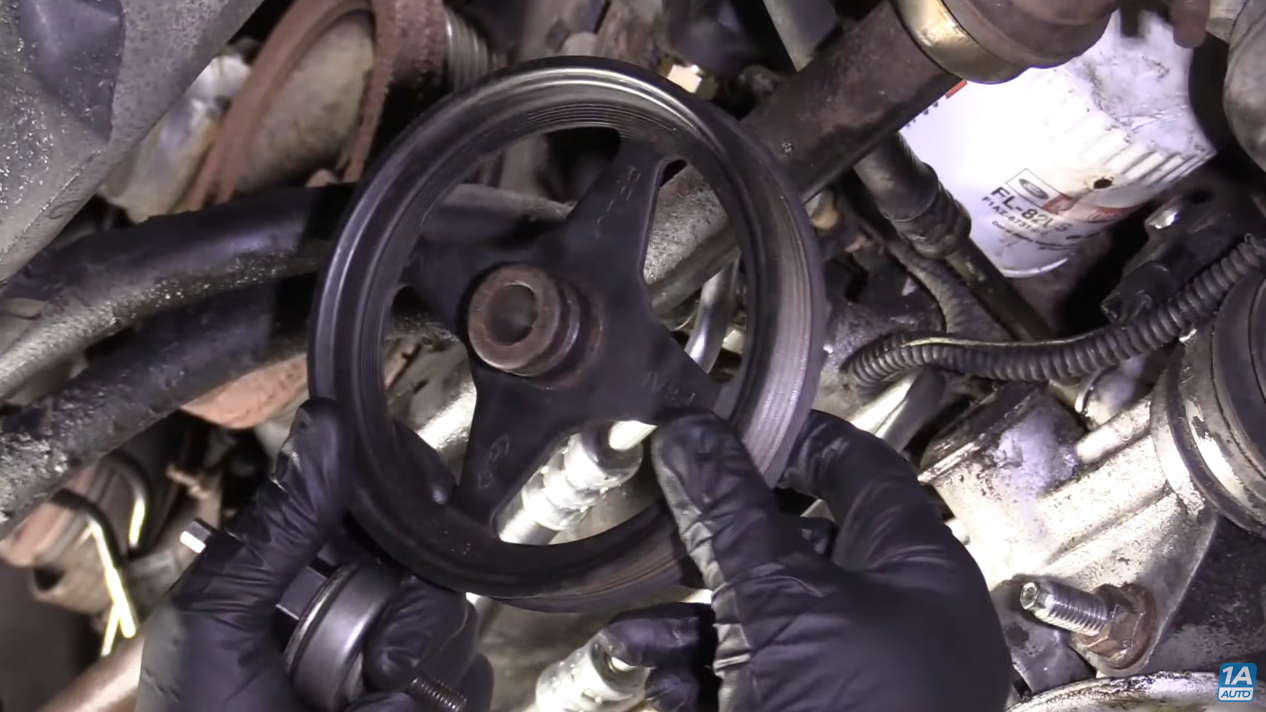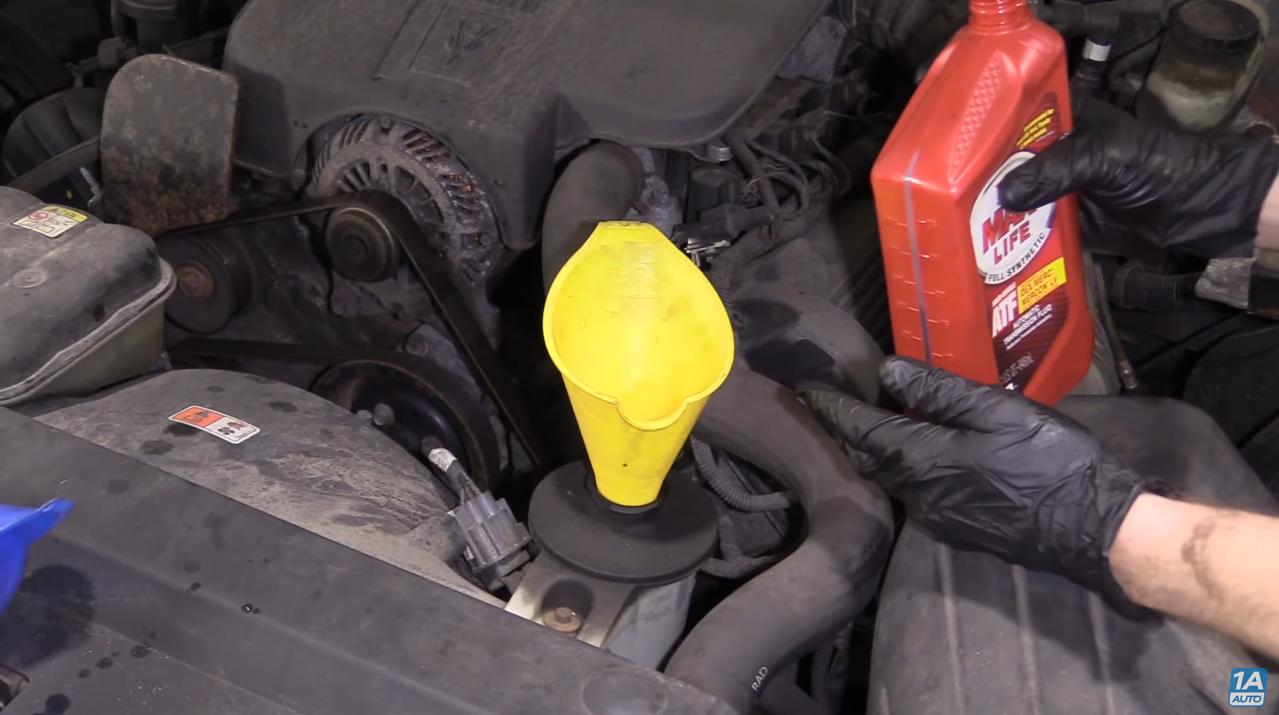There are two main issues you’ll encounter when you have a power steering leak. The first is a hearing a whining sound every time you turn the steering wheel. The second is having a smelly puddle under your car when you park it. Both are symptoms that indicate you need a power steering leak fixed immediately.
Watch the video below or read this post and we’ll teach you how to diagnose and fix a power steering leak.
How to Diagnose a Power Steering Leak
What Causes the Power Steering Fluid to Leak?
- Aging and ineffective O-rings and seals within the steering system
- Too much fluid that causes seals and valves to collapse under pressure
- Hoses that are worn out and rusted
- A leaking power steering pump
The power steering fluid acts as a lubricant within the power steering system. It’s the medium through which power is sent from the steering wheel to the vehicle’s steering mechanism.
In a car that’s working properly, the power steering fluid helps to turn the wheels quickly and effectively by pushing on the pistons that are mounted on the power steering rack. The fluid is pressurized by the steering pump. When the fluid leaks from any part of the system, it becomes ineffective. This causes difficulty in turning the car.
The fluid can leak if a seal is faulty or if components within the steering system are loosely connected. It could also be caused by worn pressure hoses.

Why Does My Steering Wheel Whine When I Turn It?
If your steering wheel makes a moaning or whining noise every time you make a turn, it’s an indication that your power steering fluid is low. When the car starts running, the little fluid gets sucked down further into the hoses and starts pulling air bubbles.
Once the air bubbles get into the steering pump, the impellers start to make noise as they move the aerated fluid. This causes the pump to produce some noise every time you steer the car or accelerate. It can be quickly fixed by adding the power steering fluid to the correct level, but if the power steering fluid is leaking, you’ll need to fix the leak.
How Much Does It Cost to Fix a Power Steering Leak?
The average cost of repairing a power steering leak falls between $500 and $1,000. This depends on the part of the steering system that needs to be fixed. It’s often more expensive if the leak is occurring where you have the pinion assembly or steering rack.
Can You Drive a Car with a Power Steering Leak?
Driving a car with a power steering leak is possible but challenging. The lack of enough steering fluid makes it difficult to turn the car. Going for extended drives over a long period of time can also cause damage to the pump. Your vehicle may experience excessive heat and friction that can result in expensive damage.
How Long Does It Take to Fix a Power Steering Leak?
If the power steering pump is responsible for the leak, it could take up to 2 hours to replace it. Replacing a return or pressure hose may take less – up to 1 hour to replace both. However, if you have a faulty power steering rack, it could take more than 2 hours to fix it.
How to Diagnose Leaking Fluid in Your Power Steering
To locate where the fluid is leaking from, you’ll need to take a closer look at your power steering system.
Steps to diagnose leaking power steering fluid
- Check the Fluid Level and Look for Air Bubbles
Open the hood of your car and check the power steering fluid reservoir. The first thing that you may notice is that the fluid is really low. Open the reservoir and check for air bubbles within the fluid.

- Check the Power Steering Fluid Reservoir and Hoses for Leaks
Check around the reservoir for any leaks. Follow through the hoses to see if any of them are leaking. If you can see the power steering pump, check around it for any moisture.
- Check for Puddles Under the Vehicle
If your reservoir and fluid hoses are fine, it’s time to get under the car. Check for a puddle that may have collected on the floor.

- Check the Power Steering Pump
A smelly puddle is a sign of a power steering fluid leak. Check the power steering pump as well as the belt and hoses that connect directly to it.

- Look for Power Steering Fluid Leaking from the Pressure Lines
Follow through the connecting pressure lines. Look for parts that have a large drip around them.
We found a spot on this vehicle along the pressure line where the power steering fluid was leaking. This was caused by metal that had rotted.
- Check the Boot and Steering Rack
Behind the bellows boot is another area that you can check. Pull the boot backward by taking off any clamps that might be holding it in place. This will reveal a rack seal.
Take a peek inside the power steering rack to see if power steering fluid is leaking. Look inside the boot and rack seal. If it’s leaking, you’ll have to replace the power steering rack. In our case, the seal was fine in this vehicle.
How to Fix a Power Steering Leak
A power steering stop leak is one way to fix a leaking power steering system, but most stop leak products only last for a short while. They are also not designed to repair serious damages.
The first step to fixing a power steering leak is to first identify where the leak is occurring. If you have a rotted pressure line, you can follow the steps provided in this article to stop the leak.
On this particular vehicle, we decided to flush out the entire power steering system, replace the rotted pressure line, and add new power steering fluid.
Steps to replace the power steering pressure line
Step 1: Start by cleaning the working area using the car parts cleaner.
Step 2: Locate the serpentine belt tensioner and remove the belt from the power steering pump pulley.
Step 3: Once the belt is out, remove the power steering pump pulley. You may need a special removal tool depending on the type of car you drive. In some cars, this step may not be necessary.
Step 4: Use a wrench to remove any fittings that are holding the pressure line to the pump.
Step 5: Locate the power steering pressure switch/sensor and disconnect it.
Step 6: Find any brackets that may be securing the pressure line and remove them.
Step 7: Unscrew any bolts holding the pressure line to loosen it. Have a collection receptacle underneath to collect the draining fluid.
Step 8: Find the point where the pressure line connects to the power steering rack. Start by cleaning the area first then unscrew the connection. This will help release the line fully.
Step 9: Compare your old pressure line to your new one. If you’re missing any sensors or brackets, make sure you swap them over. In our case, the new pressure line didn’t come with a sensor.
Tip: Remember to replace the O-ring when swapping the sensor.
Step 10: Install the new pressure line. Slide it in carefully to prevent any debris from getting in. Where the line connects to the rack, coat it with some power steering fluid before screwing it in.
Where it connects to the pump, ensure the contact point is clean.
Step 11: Reconnect your sensor and torque everything to the manufacturer’s specifications. Use your parts cleaner to clean the area where the pump pulley goes back on.
Step 12: Clean the pump pulley as well before you reinstall it. Make sure the shaft is at the same level as the pulley. Get your pulley belts back on and double-check the belt routing.
Step 13: Once everything is screwed back together, clean the hoses and pressure line. This makes it easier to check for leaks.
Steps to Bleed the Power Steering System
Step 14: Fill your fluid reservoir with the power steering fluid recommended by your manufacturer.
Step 15: Get into the car and put the key in the ON position. Do not start the engine. Turn the steering wheel to its lock position side to side several times. This helps to remove any air that’s present in the system.
Step 16: Keep your power steering fluid at hand and start the engine. Add more fluid as it runs down the power steering hoses.
Step 17: Once the fluid is at its required level, get into the car and turn the steering wheel side by side again as the vehicle runs. Listen for any noises.
Step 18: After running the car for several minutes, check the level of the power steering fluid again. If it’s at the right level, check inside the reservoir for air bubbles.
Step 19: Once you’ve confirmed the fluid level is fine and that there are no air bubbles, get under the vehicle to check for leaks.
Step 20: If there are no leaks, take the car for a road test and listen for any noises. You shouldn’t hear any moaning or whining sounds when you steer.
Have You Seen Our How-to Videos?
If you need to replace a part in your power steering system, find high-quality replacement parts at 1aauto.com. Find a how-to video specific to your year, make and model and save time and money installing it yourself.
Shop Quality Auto Parts
Featured Content
- How to bleed your power steering fluid
- How power steering works and why you may be losing fluid
- Whining noise when turning steering wheel
- Car Squeals When It’s Cold Outside? Why Your Power Steering Is Making Noise in the Cold






